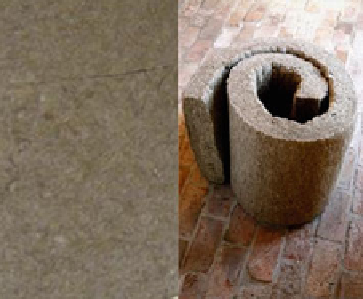Civil Engineering Reference
In-Depth Information
Fig. 8 Flax and flax fibre
insulation product
between timbers. During the past decades such fibres have been commonly used in
commercial mats and loose-fill insulations for modern houses (Kymalainen and
Sjöberg
2008
). Figure
8
shows an example of the natural flax and the processed
insulation product (
http://www.ekologiskabyggvaruhuset.se/638/linisolering
).
Thermal properties of some of the common insulations are provided in Table
3
(Kymalainen and Sjöberg
2008
).
Other typical vegetable fibres as raw materials for insulation materials include
cork from natural cork oak, kenaf, cotton, sawdust from wood, straw, moss and
wood, to cite a few examples. Many studies have been done on physical and
chemical properties of vegetable fibres as raw materials used to manufacture
thermal insulations. A life cycle assessment of a kenaf-fibre insulation board from
kenaf production and board manufacture was conducted in (Ardente et al.
2008
).
Results showed a reduction in the environmental impacts, high thermophysical and
noise-abatement properties of the insulations based on kenaf fibres. Lazko et al.
(
2011
) investigated the thermal and hygroscopic performance of insulating mate-
rials based on flax short fibres in which the linseed oil was added to improve their
hydrophobicity. They found that the high water affinity of the short fibres com-
posites was significantly reduced by a linseed-oil-based hydrophobic treatment.
Table 3 Thermal properties of some insulations with flax and hemp as raw materials, adapted
from (Kymalainen and Sjöberg
2008
) with kind permission of Elsevier, 2013
Insulation Type
Density (Kg/m
3
)
Raw material
Conductivity (W/m K)
-
Flax
-
0.040-0.046
Mat
Flax
5-50
0.038-0.075
-
Flax
20-100
0.035-0.045
-
Flax and hemp
25-40
0.050
Mat
Flax and hemp
39
0.033
Mat
Flax and hemp
19
0.060
Mat
Hemp, retted
5-50
0.040-0.082
Mat
Hemp, green
5-50
0.044-0.094
Loose-fill
Hemp, frost-retted
25-100
0.040-0.049
-
Hemp
20-45
0.040-0.060



